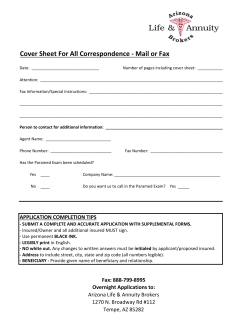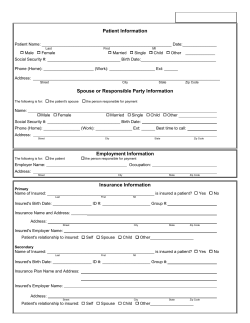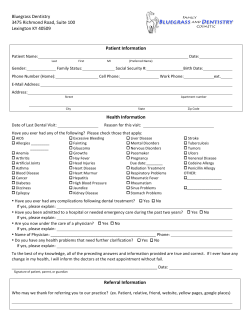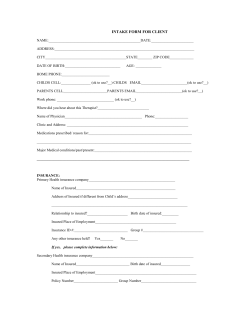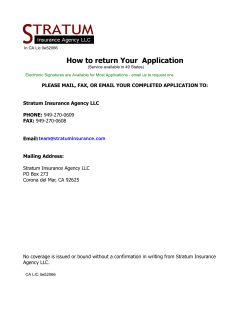
Supreme Court of Florida
Supreme Court of Florida ____________ No. SC12-1257 ____________ TRAVELERS COMMERCIAL INSURANCE COMPANY, etc., Petitioner, vs. CRYSTAL MARIE HARRINGTON, Respondent. [October 23, 2014] POLSTON, J. This case is before the Court for review of the First District Court of Appeal’s decision in Travelers Commercial Insurance Co. v. Harrington, 86 So. 3d 1274 (Fla. 1st DCA 2012). In its decision the First District ruled upon the following questions, which the court certified to be of great public importance: 1. WHETHER THE FAMILY VEHICLE EXCLUSION FOR UNINSURED MOTORIST BENEFITS CONFLICTS WITH SECTION 627.727(3), FLORIDA STATUTES, WHEN THE EXCLUSION IS APPLIED TO A CLASS I INSURED WHO SEEKS SUCH BENEFITS IN CONNECTION WITH A SINGLE-VEHICLE ACCIDENT WHERE THE VEHICLE WAS BEING DRIVEN BY A CLASS II PERMISSIVE USER, AND WHERE THE DRIVER IS UNDERINSURED AND LIABILITY PAYMENTS FROM THE DRIVER’S INSURER, WHEN COMBINED WITH LIABILITY PAYMENTS UNDER THE CLASS I INSURED’S POLICY, DO NOT FULLY COVER THE CLASS I INSURED’S MEDICAL COSTS. 2. WHETHER UNINSURED MOTORIST BENEFITS ARE STACKABLE UNDER SECTION 627.727(9), FLORIDA STATUTES, WHERE SUCH BENEFITS ARE CLAIMED BY AN INSURED POLICYHOLDER, AND WHERE A NON-STACKING ELECTION WAS MADE BY THE PURCHASER OF THE POLICY, BUT WHERE THE INSURED CLAIMANT DID NOT ELECT NON-STACKING BENEFITS. Id. at 1278-79.1 For the reasons explained below, we answer both certified questions in the negative and quash the First District’s decision.2 We conclude that a family vehicle exclusion in an automobile insurance policy, which excludes a family vehicle from the definition of an uninsured motor vehicle, does not conflict with section 627.727(3), Florida Statutes (2009). We also conclude that uninsured motorist (UM) benefits are not stackable under section 627.727(9) if the named insured or purchaser of the policy made a non-stacking election, as this waiver applies on behalf of all insureds under the policy. BACKGROUND 1. We have jurisdiction. See art. V, § 3(b)(4), Fla. Const. 2. We apply a de novo standard of review to pure questions of law. See Rando v. Gov’t Emps. Ins. Co., 39 So. 3d 244, 247 (Fla. 2010). -2- On October 29, 2009, Crystal Harrington was injured in a single-car accident, while riding as a passenger in a car owned by her father, but driven with permission by a non-family member, Joey Williams. The vehicle was insured by Travelers Commercial Insurance Company (“Travelers”). Harrington’s mother was the named insured and the purchaser of the policy on the vehicle. The policy insured three vehicles and provided liability and non-stacked uninsured motorist coverage for Harrington, her mother, and her father. Specifically, the Harrington’s policy provided for bodily injury liability coverage of $100,000 per person and $300,000 per accident, and non-stacked UM coverage of $100,000 per person and $300,000 per accident. The policy defined the term “your covered auto” as any one of the three insured vehicles, which included the vehicle involved in the accident. The driver, Joey Williams, had his own liability policy with Nationwide. Williams was also covered under the liability provisions of the Harrington’s policy because the policy defined an “insured” as the named insured, the named insured’s family, or any other person lawfully occupying the vehicle. Thus, Harrington was a class I insured and Williams was a class II insured.3 3. Typically, automobile insurance policies recognize two classes of insureds, Class I insureds and Class II insureds. “[C]lass I insureds are named insureds and resident relatives of named insureds.” Travelers Ins. Co. v. Warren, 678 So. 2d 324, 326 n.2 (Fla. 1996). Class II insureds are all other lawful occupants of an insured vehicle who are not the named insureds or a resident -3- After she was injured, Nationwide paid Harrington the $50,000 limit of Williams’ liability policy. This payment did not fully cover Harrington’s medical expenses, and Travelers also tendered its liability limit of $100,000. However, Harrington’s damages still exceeded the combined liability payments, and she subsequently sought UM benefits from Travelers. Travelers denied the claim on the ground that the vehicle was not an “uninsured motor vehicle” as defined in the policy. Specifically, the policy’s definition of an “uninsured motor vehicle” included an “underinsured” vehicle, that is a vehicle to which a liability policy applies at the time of the accident but the amount paid under the policy is not enough to pay the full amount of the insured’s damages. However, the policy also contained a “family vehicle exclusion” which expressly provided that an uninsured vehicle does not include any vehicle: Owned by or furnished or available for the regular use of you or a “family member” unless it is a “your covered auto” to which Coverage A of the policy applies and bodily injury liability coverage is excluded for any person other than you or any “family member” for damages sustained in the accident by you or any “family member[.]” Therefore, the vehicle in question was excluded from UM coverage pursuant to this provision. relative of the named insured; essentially, they are “third party beneficiaries to the named insureds’ policy.” Id. -4- After Travelers denied her claim for UM benefits, Harrington sued Travelers, seeking payment of stacked UM benefits in the amount of $300,000, despite the fact that her mother, the named insured and purchaser of the policy, had expressly selected and paid for non-stacking UM coverage. Before trial, both parties moved for summary judgment, and the trial court granted summary judgment in favor of Harrington, concluding that the policy provision excluding family vehicles from UM coverage was invalid because it conflicted with section 627.727(3)(b) and (c), Florida Statutes (2009). The trial court also concluded that the waiver executed by Harrington’s mother electing non-stacking UM coverage did not apply to Harrington because Travelers did not obtain a knowing acceptance of the limitation of non-stacking UM coverage from Harrington personally. On appeal, the First District affirmed the trial court’s ruling on both the coverage and stacking issues, but reversed the amount of the UM benefits awarded and the attorney’s fees awarded because “Travelers’ asserted other defenses which might impact the amount of the benefits due under the policy.” Harrington, 86 So. 3d at 1278. The First District then certified two questions of great public importance to this Court. Id. at 1278-79. ANALYSIS I. Whether the Family Vehicle Exclusion Conflicts With Section 627.727(3), Florida Statutes -5- The first question before us is whether the family vehicle exclusion for UM coverage conflicts with section 627.727(3), Florida Statutes (2009). More specifically, whether the exclusion conflicts with subsection (b) or (c) of section 627.727(3), when applied to a class I insured, injured in a car accident, who seeks UM benefits when the combined liability payments from the class II insured’s policy and the class I insured’s own policy do not fully cover the insured’s medical expenses.4 As explained below, we find that the exclusion does not conflict with either subsection. A. Whether the Policy Exclusion Conflicts With Section 627.727(3)(b), Florida Statutes Under Florida law, insurers are required to provide UM coverage for all vehicles insured for liability purposes, unless the insured expressly rejects UM coverage. See generally § 627.727(1), Fla. Stat. (2009). In enacting the UM statute, section 627.727, the Legislature intended “to provide for the broad protection of the citizens of this State against uninsured motorists.” Salas v. Liberty Mut. Fire Ins. Co., 272 So. 2d 1, 5 (Fla. 1972). But, as originally enacted, “UM coverage came into play only when the offending owner or operator carried 4. Subsection (a), which provides that an insured vehicle may be treated as uninsured if the liability insurer “[i]s unable to make payment with respect to the legal liability of its insured within the limits specified therein because of insolvency,” is not at issue here. § 627.727(3)(a), Fla. Stat. (2009). -6- no liability insurance whatsoever.” Shelby Mut. Ins. Co. v. Smith, 556 So. 2d 393, 393 (Fla. 1990). This meant that “the tortfeasor had to be completely uninsured before [UM] coverage was required to be applicable. Even if an accident victim’s recovery from the tortfeasor’s insurer was less than his damages, the statute did not originally require uninsured vehicle coverage to be available for further compensation.” Williams v. Hartford Accident & Indem. Co., 382 So. 2d 1216, 1218 (Fla. 1980). However, in 1973, the Legislature created subsection 627.727(3)(b) (originally subsection 627.727(2)(b)) to provide UM coverage for underinsured tortfeasors as well. See Smith, 556 So. 2d at 393-94; see also ch. 73180, § 4, Laws of Fla. This subsection provides as follows: (3) [T]he term “uninsured motor vehicle” shall, subject to the terms and conditions of such coverage, be deemed to include an insured motor vehicle when the liability insurer thereof: .... (b) Has provided limits of bodily injury liability for its insured which are less than the total damages sustained by the person legally entitled to recover damages[.] § 627.727(3)(b), Fla. Stat. (2009). Harrington argues, and the First District concluded, that the family vehicle exclusion in the Travelers policy is void because it conflicts with section 627.727(3)(b), which provides that underinsured vehicles shall be considered uninsured for purposes of UM coverage, and that Harrington is entitled to both -7- liability and UM benefits under the Travelers policy. See Harrington, 86 So. 3d at 1276-77. We disagree. While section 627.727(3)(b) provides that underinsured vehicles shall be considered uninsured for purposes of UM coverage, it also provides that the term uninsured motor vehicle is “subject to the terms and conditions of such coverage.” § 627.727(3)(b), Fla. Stat. And, an insurance “ ‘policy may contain other general conditions affecting coverage or exclusions on coverage’ as long as the limitations are unambiguous and ‘consistent with the purposes of the UM statute.’ ” Sommerville v. Allstate Ins. Co., 65 So. 3d 558, 562 (Fla. 2d DCA 2011) (quoting Varro v. Federated Mut. Ins. Co., 854 So. 2d 726, 728-29 (Fla. 2d DCA 2003)). Here, the terms and conditions of the insurance policy expressly and unambiguously excluded the vehicle in question from the definition of an “uninsured motor vehicle.” Thus, the family vehicle exclusion does not conflict with section 627.727(3)(b) because the statute clearly states that the term “uninsured motor vehicle” is subject to the terms and conditions of the policy. Furthermore, we have historically upheld such policy definitions. See, e.g., Smith v. Valley Forge Ins. Co., 591 So. 2d 926, 927 (Fla. 1992) (holding that the insurance policy’s provision excluding “any vehicle that is ‘owned by or furnished or available for the regular use of you or any family member’ ” from the definition of an uninsured vehicle was valid and precluded the recovery of UM benefits); -8- Reid v. State Farm Fire & Cas. Co., 352 So. 2d 1172, 1173 (Fla. 1977) (holding that a policy may exclude the vehicle it insures from the definition of an uninsured motor vehicle); see also Nationwide Mut. Fire Ins. Co. v. Olah, 662 So. 2d 980, 982 (Fla. 2d DCA 1995) (reversing an award of UM benefits because the policy contained a valid exclusion limiting UM benefits to a vehicle not covered under the liability section of the policy); State Farm Mut. Auto. Ins. Co. v. McClure, 501 So. 2d 141, 142-43 (Fla. 2d DCA 1987) (concluding that the policy definition of “uninsured motor vehicle” which excluded a vehicle insured under the liability portion of the policy was not void against public policy). Moreover, as we explained in Travelers Insurance Co. v. Warren, 678 So. 2d 324, 326-27 (Fla. 1996), “section 627.727(3)(b) does not require a stacking of both liability and UM benefits under the same policy[,]” and section 627.727(3)(b) does not negate the effect of a policy’s “your car” exclusion. Although in Warren, we were addressing a claim by a class II insured seeking UM benefits as opposed to a class I insured like Harrington, this is not a material distinction. Indeed, the facts in Warren are virtually identical to the facts of this case and compel the same result. Specifically, like Harrington, Dianna Warren was a passenger in a vehicle, insured by Travelers, that was involved in an accident that resulted in Warren’s death. Id. at 325-26. Similar to the case at hand, the Travelers policy in Warren -9- contained a “your car” exclusion, which provided that the car insured under the policy was not an uninsured motor vehicle within the meaning of the policy. Id. at 326. Warren’s estate, like Harrington, collected the liability limits from Travelers and then sought to collect UM benefits from Travelers on the ground that the vehicle was underinsured because the damages exceeded the liability limits. Id. The trial court granted summary judgment for Travelers on the basis of the policy’s exclusion, but the “[First District] reversed, concluding that section 627.727(3)(b)[,] overrode the insurance policy’s ‘your car’ exception, thereby allowing [Warren’s] estate to recover both liability and UM benefits under the same policy.” Id. (footnote omitted). However, on review, a plurality of this Court quashed the First District’s decision, concluding that section 627.727(3)(b) did not negate the effect of the policy’s “your car” exclusion and “that the ‘liability insurer’ referred to in section 627.727(3)(b) means an insurer other than the insurer providing UM coverage to the claimant.” Id. at 327-28. Thus, given our holding in Warren, Harrington could not receive UM benefits under the Travelers policy because Travelers already paid out the liability limits. To hold otherwise would not only permit stacking of liability and UM coverages under the same policy, but it would also require treating a vehicle as both insured and uninsured under the same policy in contravention of a long line of well-established precedent. See, e.g., Reid, 352 So. 2d at 1173-74 (holding that a vehicle cannot be both insured - 10 - and uninsured under the same policy); Bulone v. United Servs. Auto. Ass’n, 660 So. 2d 399, 400-02 (Fla. 2d DCA 1995) (explaining that the UM statute does not require an automobile policy to treat vehicles as both insured for purposes of liability coverage and uninsured for purposes of UM coverage); Allstate Ins. Co. v. Baker, 543 So. 2d 847, 850 (Fla. 4th DCA 1989) (“[A] vehicle cannot be transformed from an insured vehicle into an uninsured vehicle simply because liability coverage was barred due to a valid enforceable household exclusion in the same policy[.]”). Accordingly, we conclude that the family vehicle exclusion does not conflict with section 627.727(3)(b). B. Whether the Exclusion Conflicts With Section 627.727(3)(c), Florida Statutes The first certified question also requires us to consider whether the family vehicle exclusion conflicts with section 627.727(3)(c), Florida Statutes (2009). For the reasons explained below, we find that it does not. Section 627.727(3)(c) provides UM coverage for an insured vehicle when the insurer excludes liability coverage for a non-family member, who while driving the insured vehicle, injures the named insured or the named insured’s family. Specifically, the statute provides as follows: (3) For the purpose of this coverage, the term “uninsured motor vehicle” shall, subject to the terms and conditions of such coverage, - 11 - be deemed to include an insured motor vehicle when the liability insurer thereof: .... (c) Excludes liability coverage to a nonfamily member whose operation of an insured vehicle results in injuries to the named insured or to a relative of the named insured who is a member of the named insured’s household. § 627.727(3)(c), Fla. Stat. (2009) (emphasis added). As we explained in Warren, 678 So. 2d at 328, the Legislature created subsection (3)(c) to provide UM coverage when a non-family member’s operation of an insured family vehicle results in an injury to an insured and the insurer excludes liability coverage for the non-family member. The family vehicle exclusion here does not conflict with subsection (3)(c) because the liability policy does not exclude coverage for non-family members. Rather, the Harrington’s liability policy, consistent with the purposes of subsection (3)(c), covers any person who drives, with permission, any of the vehicles insured under the policy, and also provides that an insured vehicle is considered uninsured for purposes of UM coverage if the liability policy excludes coverage for non-family members whose operation of the vehicle cause injury to the named insured or the named insured’s family. Thus, there is no conflict. Furthermore, as we explained in Warren, 678 So. 2d at 328, “section 627.727(3)(c) d[oes] not stack UM coverage on top of liability coverage under a single policy.” - 12 - Accordingly, we hold that the family vehicle exclusion does not conflict with section 627.727(3)(c), Florida Statutes (2009). We therefore answer the first certified question in the negative. II. Stacking of UM Benefits Under Section 627.727(9), Florida Statutes The second certified question before us is whether UM benefits are stackable under section 627.727(9), Florida Statutes (2009), when the named insured and purchaser of the policy expressly elected non-stacking UM coverage, but the insured claiming the UM benefits did not expressly make a non-stacking election. We answer this question in the negative and conclude that the coverage election made by the named insured is binding on behalf of all insureds under the policy. While stacking of UM coverage is presumptive under Florida law, section 627.727(9) provides that an insurer may offer non-stacking coverage provided that the insurer informs the insured of the limitations of such coverage and the insured executes an approved form expressly electing non-stacking coverage. See generally § 627.727(9), Fla. Stat. (2009). In this case, upon purchasing the policy, Harrington’s mother, the named insured, executed a coverage election form expressly electing non-stacking UM coverage and, as a result of this election, paid a corresponding lower insurance premium. The additional insureds under the policy, Harrington and her father, did not sign the form. Despite this election, the trial court and the First District concluded that the election of non-stacking - 13 - coverage did not apply to Harrington because she did not personally sign the form waiving stacked UM coverage. Harrington, 86 So. 3d at 1277. In reaching this conclusion, the courts focused on the difference in the statutory language found in section 627.727(9) from that found in section 627.727(1), Florida Statutes (2009). Section 627.727(1) requires that UM coverage be provided with any liability policy in equal limits to the liability policy, unless the insured expressly rejects the coverage or elects lower coverage limits by executing an approved form. § 627.727(1), Fla. Stat. This section further provides that “[i]f this form is signed by a named insured, it will be conclusively presumed that there was an informed, knowing rejection of coverage or election of lower limits on behalf of all insureds.” Id. (emphasis added). Similarly, section 627.727(9) requires that an election of non-stacking UM coverage be expressly made by executing an approved form and further provides that “[i]f this form is signed by a named insured, applicant, or lessee, it shall be conclusively presumed that there was an informed, knowing acceptance of such limitations.” § 627.727(9), Fla. Stat. Because the phrase “on behalf of all insureds” is not present in subsection (9), the First District agreed with the trial court that the Legislature intended that “the subsection (9) waiver of stackable coverage must be personally made by the insured who claims such benefits.” Harrington, 86 So. 3d at 1277. We disagree. - 14 - As a preliminary matter, we note that the First District did not have to resort to statutory interpretation in order to determine whether Harrington’s mother’s election of non-stacking coverage applied on behalf of all the insureds under the policy because the contract unambiguously stated that the coverage selection applied on behalf of all insureds under the policy.5 See, e.g., State Farm Mut. Auto. Ins. Co. v. Menendez, 70 So. 3d 566, 569 (Fla. 2011) (“In interpreting an insurance contract, we are bound by the plain meaning of the contract’s text.”); V & M Erectors, Inc. v. Middlesex Corp., 867 So. 2d 1252, 1253 (Fla. 4th DCA 2004) (“[W]here the contract [language] is clear and unambiguous there is no reason to go further.” (quoting Lab. Corp. of Am. v. McKown, 829 So. 2d 311, 313 (Fla. 5th DCA 2002))); Gen. Sec. Ins. Co. v. Barrentine, 829 So. 2d 980, 981-82 (Fla. 1st DCA 2002) (“If the language of an insurance policy is clear, it must be construed to mean what it says and nothing more. Courts have no power to create insurance coverage, if it does not otherwise exist by the terms of the policy.” (internal citations omitted)). 5. Specifically, the coverage election form stated that “I, on behalf of all insureds under the policy, understand and agree that selection of any of the above options applies to my liability insurance policy and future renewals or replacements of such policy which are issued at the same Bodily Injury Liability Limits.” - 15 - Nevertheless, the First District concluded that the Legislature did not intend for the named insured’s election to apply on behalf of all the insureds under the policy since, unlike in section 627.727(1), the Legislature did not expressly include the language “on behalf of all insureds” in the presumption clause in section 627.727(9). Under the First District’s interpretation, any insured under the policy, other than the named insured who signed the waiver, would be able to collect stacked UM benefits, despite the fact that the named insured affirmatively made a non-stacking election and paid a reduced premium based on this election. Not only would this put the additional insureds in a better position than the named insured— giving them a benefit they did not pay for—but it also prevents the insurer from receiving the “reduced liability risk” that they bargained for. See Acquesta v. Indus. Fire & Cas. Co., 467 So. 2d 284, 285 (Fla. 1985) (“[The insured] correctly expects the insurance company to be bound by the contract in all respects which are of benefit to him and the law will enforce those expectations. [Likewise, t]he insurer correctly expects [the insured] to be bound in all respects which are of benefit to it. More precisely, both are entitled to all they bargained and paid for.” (quoting Indus. Fire & Cas. Co. v. Acquesta, 448 So. 2d 1122, 1123 (Fla. 4th DCA 1984))). In addition, automobile insurers have never provided individualized UM coverage; instead, UM coverage premiums are calculated based on the coverage - 16 - selected for the policy as whole. Yet, the First District’s interpretation creates the potential predicament that individuals under the same policy will elect both stacked and non-stacked UM benefits, making the calculation of a single UM premium impractical, as well as virtually impossible. See Cont’l Ins. Co. v. Roth, 388 So. 2d 617, 618 (Fla. 3d DCA 1980) (“We envision no rational apportionment of the [UM] premium among named insureds, should some want the coverage, and others not; nor can we believe that it was the intention of the legislature, [the insurer], or the [insured], that a bargain for [UM] coverage be struck per capita, within each policy, rather than on a policy-by-policy basis.”). Accordingly, we hold that a waiver executed by the named insured electing non-stacking UM coverage is binding on all insureds under the policy under section 627.727(9). We therefore answer the second certified question in the negative. CONCLUSION For the reasons explained above, we answer both certified questions in the negative and quash the First District’s decision. It is so ordered. LABARGA, C.J., and PARIENTE, QUINCE, CANADY, and PERRY, JJ., concur. LEWIS, J., concurs in result. NOT FINAL UNTIL TIME EXPIRES TO FILE REHEARING MOTION, AND IF FILED, DETERMINED. - 17 - Application for Review of the Decision of the District Court of Appeal - Direct Conflict of Decisions First District - Case No. 1D11-15 (Columbia County) James Paul Waczewski of Luks, Santaniello, Petrillo, & Jones, Tallahassee, Florida, and Raoul G. Cantero, III, and Maria Josefa Beguiristain of White & Case LLP, Miami, Florida, for Petitioner Stephen Charles Bullock and Christopher M. Costello of Brannon, Brown, Haley & Bullock, P.A., Lake City, Florida, for Respondent Cynthia Skelton Tunnicliff and Gerald Don Nelson Bryant, IV, of Pennington, Moore, Wilkinson, Bell & Dunbar, P.A., Tallahassee, Florida, for Amicus Curiae Personal Insurance Federation of Florida Henry Gerome Gyden and Dorothy Venable DiFiore of Haas, Lewis, & DiFiore, P.A., Tampa, Florida, for Amicus Curiae GEICO Insurance Company Louis Kahn Rosenbloum of Louis K. Rosenbloum, P.A., Pensacola, Florida, for Amicus Curiae The Florida Justice Association - 18 -
© Copyright 2025
